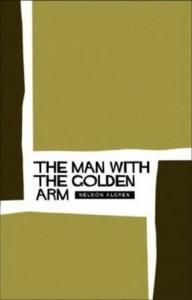Fiction of the American underclasses
by Douglas CowieDuring Presidential election campaigns, the men and women who aspire to the White House pitch themselves as the Wizard of Oz (or are they Dorothy?) – who will lead all Americans to the Emerald City about which they dream – and the myth of America’s cultural identity as a land of opportunity and dreams shines both most brightly and most emptily. It’s nothing new or original to point out that those opportunities aren’t available to everyone in America, and that most of those dreams will go unrealised, regardless of who follows whom into 1600 Pennsylvania Avenue. Nelson Algren wrote that “literature is made upon any occasion that a challenge is put to the legal apparatus by conscience in touch with humanity.” Away from the bluster of electoral politics those “conscience(s) in touch with humanity”, challenging us to improve society by doing something about those left behind by the American Dream, take the form of groups and movements that try to include them and insist on their voices and experiences: the Black Panther Party, Daughters of Bilitis, Occupy or Black Lives Matter, to name only a few. In literature, ever since Walt Whitman’s 1855 Leaves of Grass, which in both form and content asked America to view its myth and identity as something both more and better than the official version, American writers have tried to include and insist on those same voices and experiences, by imagining and reimagining the lives of those underclasses that American politics leaves behind. They give literary voice to those excluded from the main current of American life by their poverty, their race, their sexuality, their geography, their experiences (it seems almost anything can cause one to find oneself spat out from the river of American progress).
Away from the bluster of electoral politics those ‘conscience(s) in touch with humanity’ take the form of groups and movements that try to include them and insist on their voices and experiences.”
In each of the novels that follows, a conscience in touch with humanity has succeeded in creating Algren’s challenge. The authors have imagined characters and situations which allow readers to see people who may not be superficially like them, as people who share a common desire to both understand and articulate themselves as members of American society. These ten works of fiction span, chronologically, three-quarters of a century of American literature.
I decided to create a highly subjective list of novels – ones that have, over a long time, or more recently, influenced my thinking about my own writing in significant ways. If I’d used a less subjective method, there are plenty of other novels and novelists I might have included here, not to mention non-fiction and poetry books as well. William S. Burroughs, Alice Walker, Kathy Acker, Toni Morrison, Sherman Alexie, Jill Leovy, David Simon, Langston Hughes, Gwendolyn Brooks… it’s a long list, and it really only starts here.
The Grapes of Wrath by John Steinbeck (1939)
Most of what I know about Okies I learned from John Steinbeck’s novel and Woody Guthrie’s songs (I’ll leave Merle Haggard alone). Steinbeck’s engagement with the hordes of poor people who travelled from Oklahoma to California when their farms and banks and lives blew away in the dust is at once hard realism, allegory and heart-on-sleeve socialism. I read it in my sophomore year of high school, and felt deeply challenged by all three of those aspects. From that way of thinking, it’s a life-changing book, as the best ones always are.
Native Son by Richard Wright (1940)
 Unlike Ralph Ellison’s protagonist (see below), Bigger Thomas isn’t an educated, articulate, ambitious young man. He’s young, and not particularly bright, but he’s smart enough to know his dreams will remain deferred, and to understand that white people’s attitudes to race, well-intentioned and ill-intentioned, conspire against him, and trap him in a life in which he can barely act without fear of the repercussions. The key achievement of Wright’s novel is to dramatise Bigger’s character and predicament with an eloquence denied to the character himself, and to dramatise the legal, economic and social ways in which racism becomes murder of the race viewed as an underclass – not metaphorical murder, but literal murder.
Unlike Ralph Ellison’s protagonist (see below), Bigger Thomas isn’t an educated, articulate, ambitious young man. He’s young, and not particularly bright, but he’s smart enough to know his dreams will remain deferred, and to understand that white people’s attitudes to race, well-intentioned and ill-intentioned, conspire against him, and trap him in a life in which he can barely act without fear of the repercussions. The key achievement of Wright’s novel is to dramatise Bigger’s character and predicament with an eloquence denied to the character himself, and to dramatise the legal, economic and social ways in which racism becomes murder of the race viewed as an underclass – not metaphorical murder, but literal murder.
The Man with the Golden Arm by Nelson Algren (1949)
The story of a card-dealing junkie/would-be jazz drummer, Algren’s novel is really a portrait of an impoverished Chicago Polish community, and the dreams, frailties and downright moral decrepitude of its people, who all lead lives which cannot escape the political forces that are always watching, but only ever act in an election year. The power of Algren’s novel – and his work in general – is that the tragedies are always every bit as personal as they are political, and vice versa. He creates a narrative voice at once lyrical, tender and cynical, to tell his stories in a way that never abandons the people they involve, even when you might think they deserve it.
Invisible Man by Ralph Ellison (1952)
Ralph Ellison’s chaotic novel sees his protagonist constantly trying to prove himself worthy of his ambitions, and constantly exploited by people who see him not as an individual human being, but as an emblem of his race. The sharp vision of this novel comes most alive to me in the relationship between three moments: Bledsoe touches a slave shackle as he hands over the reference letter that will damn the protagonist to failure; that letter itself, and the poetic language it uses to condemn the protagonist: “I beg of you, sir, to help him continue in the direction of that promise which, like the horizon, recedes ever brightly and distantly beyond the hopeful traveler”; the distillation of that language into its awful truth, in a dream: “To Whom It May Concern,” I intoned. “Keep This Nigger-Boy Running.” Ralph Ellison does not pull his punches.
Another Country by James Baldwin (1962)
The irony of the title is that for the characters, they can’t really be at home in their own country of birth – or anyplace else, for that matter (France proves a temporary refuge for some). Baldwin’s novel seethes with anger at a society that stamps down on intelligent, passionate people, making outsiders of them because of race and sexuality. His genius here is that his rage explodes from his sentences without trampling over his form, characters and plot.
 Trilobites and Other Stories by Breece D’J Pancake (1983)
Trilobites and Other Stories by Breece D’J Pancake (1983)
This isn’t a novel, but Breece D’J Pancake’s stories, nearly all of which take place among hillbillies in Appalachia, are incredible. The geography, geology, flora and fauna of Appalachia are every bit as much characters in these stories as the people, and those people learn hard lessons from each other, themselves, and their environment. The stories are as beautiful as they are tough, and deserve a high place in the hierarchies of American canon-making.
Northline by Willy Vlautin (2008)
I could have picked any of Willy Vlautin’s four novels for this list. He writes simply and elegantly about people trying to live good lives in bad situations, and the mistakes they make along the way. Part of the value of Vlautin’s work is his investment in the genuineness of not only the cruelty people enact on themselves and others, but also the basic kindness that offers the hope of something better. There’s real elegance in the simplicity of his stories.
The Lazarus Project by Aleksandar Hemon (2008)
Aleksandar Hemon tells two intertwining stories of immigration and the violence of nationalist-fascistic power in The Lazarus Project. Hemon sets a Jewish immigrant experience of nineteenth-century Chicago against the experiences of late twentieth-/early twenty-first-century Bosnian immigrant experience to both intelligent and devastating effect. Ethnic cleansing, its perpetrators and survivors, and the languages and exiles that enable survival and perpetration, all entwine in this work by one of the finest writers in the English language today.
Preparation for the Next Life by Atticus Lish (2014)
A Uighur undocumented immigrant woman and an Iraq war veteran forge a fragile romance in Atticus Lish’s debut novel. Lish explores in painstaking detail the precariousness of life at the margins of society, and the physical and psychological violence people both endure and commit as they try to survive the lives that have been forced upon them. One of the great feats of this novel is that almost nothing happens, and yet everything carries the weight of lived life, compellingly told. The plights and fates of his characters are hard to live with, and yet impossible to ignore; the novel demands you look its people straight in the face, even when the characters themselves won’t.
All Involved by Ryan Gattis (2015)
Seventeen narrators spin their interweaving stories in this long but fast-reading account of Los Angeles in the grips of the 1992 riots. The most prominent voices in Gattis’s novel are those of the Latino gang members who use the riots as cover for their own wars of revenge, but caught in the vortex of urban America’s many acts of violence, too, are firefighters, nurses, shopkeepers – yes, like the title’s adoption of gang terminology implies, it’s you and me, too.
 Douglas Cowie is originally from Chicago and has lived in England and Berlin since 1999. He is a Senior Lecturer in Creative Writing at Royal Holloway, University of London. His first novel, Owen Noone and the Marauder, was published in 2005. Most recently he has published two linked novellas, Sing for Life: Tin Pan Alley and Sing for Life: Away, You Rolling River. His latest novel Noon in Paris, Eight in Chicago, charting the tragic love affair between Simone de Beauvoir and Nelson Algren, is published by Myriad Editions. Read more.
Douglas Cowie is originally from Chicago and has lived in England and Berlin since 1999. He is a Senior Lecturer in Creative Writing at Royal Holloway, University of London. His first novel, Owen Noone and the Marauder, was published in 2005. Most recently he has published two linked novellas, Sing for Life: Tin Pan Alley and Sing for Life: Away, You Rolling River. His latest novel Noon in Paris, Eight in Chicago, charting the tragic love affair between Simone de Beauvoir and Nelson Algren, is published by Myriad Editions. Read more.


